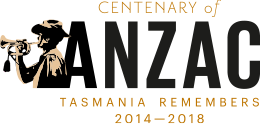12th Australian Infantry Battalion

The 12th Battalion marching through the city of Hobart prior to embarking for service overseas. The mounted officer on the extreme right at the head of the Battalion is Colonel L. F. Clarke who was one of the first officers to be killed in the Gallipoli landing. Photo by J.W. Beattie. Australian War Memorial H11609

Brigadier General E E Sinclair Maclagan, Officer Commanding (OC), 3rd Brigade (left), Major Ross, West Yorks Regiment, Brigade Major, 3rd Brigade, AIF (centre) and Major Carter, Medical Officer (MO) Australian Army Medical Corps (AAMC), 12th Battalion (right) standing outside 12th Battalion Headquarters at Dead Man's Gully. Australian War Memorial AO1474
The 12th Australian Infantry Battalion was one of the four battalions, along with the 9th, 10th and 11th, which made up the 3rd Brigade.
Half of the men in the battalion were Tasmanian, the other half South Australian and Western Australian.
It was one of the first battalions established for the Australian Imperial Force in the First World War.
The battalion landed in Egypt in December 1914 where many Australian troops were initially sent to protect British interests in the Middle East.
Gallipoli
The 12th Battalion was also on the front line at the Gallipoli landing, being the first to arrive at ANZAC Cove in the early hours of the morning on 25 April 1915.
In August 1915, the battalion participated in the attack on Lone Pine, an attempt to take the third and fourth lines of the Turkish trenches. This was part of a strategy to draw Turkish focus away from the real objective of the ANZAC assault. The battle that took place was a bloody and brutal one within the tight space of the trenches. Troops had to engage in close-proximity and hand-to-hand combat, with soldiers on both sides accidentally killing their comrades in the confusion.
One soldier described the event thus: “We were like a mob of ferrets in a rabbit warren. It was one long grave, only some of us were still alive in it.”
Lone Pine was largely considered a success, although some 2,200 Australians were killed or wounded.
The 12th Battalion occupied Gallipoli right up until the evacuation in December.
Western Front
In March 1916, they were moved to the Western Front. They fought in Pozieres in France’s Somme Valley, and later at Ypres in Flanders. Then in 1917 they partook in an advance against the Germans which forced the enemy back to the Hindenburg Line.
Among the troops of the 12th Battalion was Sergeant John Whittle of Huon Island who earned himself military esteem and the Victoria Cross at a battle near the French villages of Boursies and Lagnicourt. Sergeant Whittle is reported to have run across fire-engulfed land towards a machine-gun crew, taking it out before they could assault him and his troops.
The 12th Battalion later fought in the Third Battle of Ypres in Belgium, and the allied offensive of 1918. This was one of the most successful Allied advances on the Western Front.
The 12th Battalion’s activities on the Western Front ended in September 1918.

